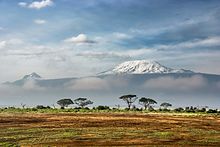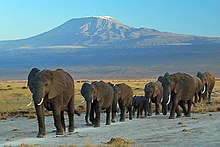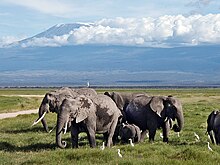

| Amboseli National Park | |
|---|---|
|
Show map of Tsavo national parks
Location of Amboseli National Park within Kenya Show map of Kenya | |
| Location | Loitoktok District, Kajiado County, Kenya |
| Nearest city | Nairobi |
| Coordinates | 02°38′29″S 37°14′53″E / 2.64139°S 37.24806°E / -2.64139; 37.24806 |
| Area | 392 km2 (151 sq mi) |
| Established |
|
| Visitors | 120,000 estimated (in 2006) |
| Governing body | Kenya Wildlife Service, Olkejuado County Council and the Maasai community |
Amboseli National Park, formerly Maasai Amboseli Game Reserve, is a national park in Loitoktok District in Kajiado County, Kenya.[1] It is 39,206 ha (392.06 km2) in size at the core of an 8,000 km2 (3,100 sq mi) ecosystem that spreads across the Kenya-Tanzania border.[2] The local people are mainly Maasai, but people from other parts of the country have settled there attracted by the successful tourist-driven economy and intensive agriculture along the system of swamps that makes this low-rainfall area, average 350 mm (14 in), one of the best wildlife-viewing experiences in the world with 400 species of birds including water birds like pelicans, kingfishers, crakes, hamerkop and 47 raptor species.[3]
The park protects two of the five main swamps and includes a dried-up Pleistocene lake and semiarid vegetation.

In 1883, Jeremy Thompson was the first European to penetrate the feared Maasai region known as Empusel (meaning 'salty, dusty place' in Maa). He, too, was astonished by the fantastic array of wildlife and the contrast between the arid areas of the dry lake bed and the oasis of the swamps, a contrast that persists today.
Amboseli was set aside as the Southern Reserve for the Maasai in 1906 but returned to local control as a game reserve in 1948. Gazetted a national park in 1974 to protect the core of this unique ecosystem, it was declared a UNESCO site in 1991. The park earned $3.5 m (€2.9 m) in 2005. On 29 September 2005, Kenyan President Mwai Kibaki declared that control of the park should pass from the Kenya Wildlife Service to the Olkejuado County Council and the Maasai tribe. Some observers saw this as a political favour in advance of a vote on a new Kenyan constitution; legal challenges are currently in court. The degazetting would divert park admission fees directly to the county council with shared benefits to the Maasai immediately surrounding the park.



The park is famous for being the best place in the world to get close to free-ranging elephants.[4] Other attractions of the park include opportunities to meet Maasai and visit a Maasai village. The park also has views of Mount Kilimanjaro, the highest free-standing mountain in the world.
Amboseli was home to Echo, the most researched elephant in the world, and the subject of many books and documentaries, followed for almost four decades by American conservationist Dr. Cynthia Moss. Echo died in 2009 when she was about 60 years old.[5]
The park was also a refuge to an impressive bull elephant named Tim whose size and tusks became iconic . He died of natural causes on the 5th of February 2020.
Amboseli National Park offers some of the best opportunities to see African wildlife because the vegetation is sparse due to the long, dry months. The protected area is home to African bush elephant, Cape buffalo, impala, lion, cheetah, spotted hyena, Masai giraffe, Grant's zebra, and blue wildebeest. A host of large and small birds occur too.[6][7]
The park has several rules to protect the wildlife: Never leave the vehicle, except at designated spots; do not harass the animals in any way; always keep to the tracks; no off-road driving; and always give the animals the right of way. The roads in Amboseli have a loose surface of volcanic soil that is dusty in the dry season and impassable in the wet season.[8][9]
A small airport is in Amboseli, the Amboseli Airport (HKAM).
| International |
|
|---|---|
| National |
|
| Other |
|